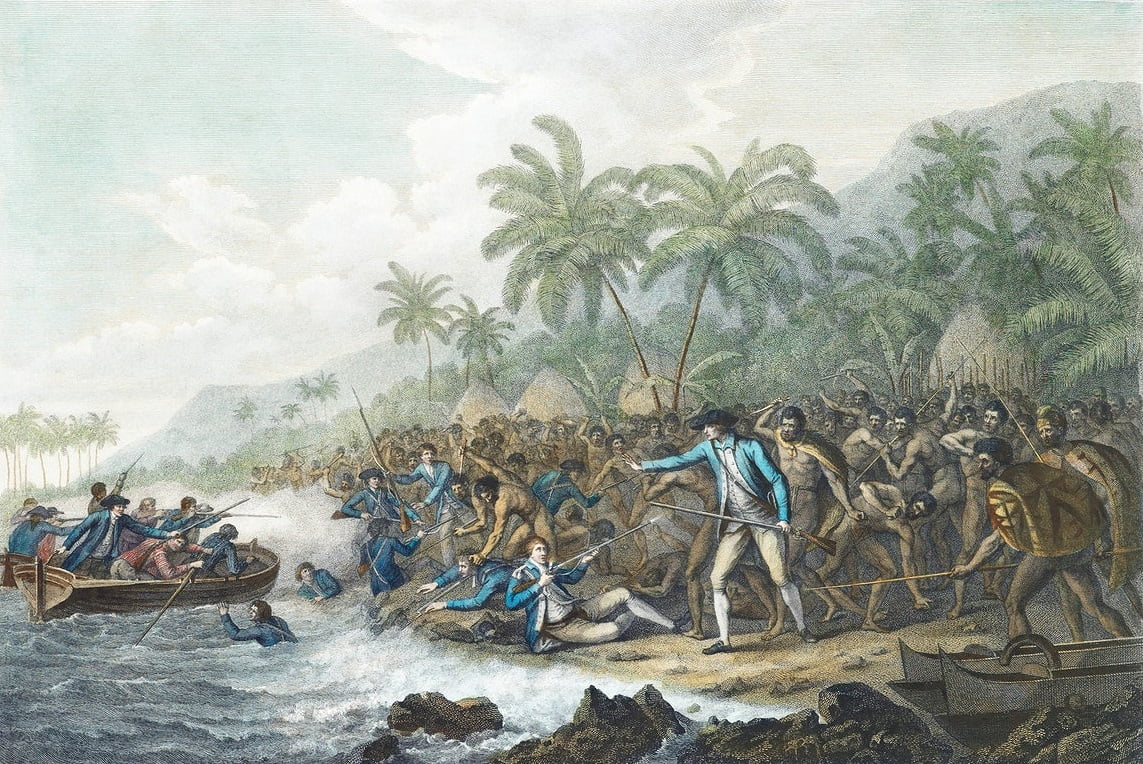English navigator and explorer James Cook died in 1779 in Hawaii. We checked to see if he was a victim of cannibals.
James Cook is one of the most famous travelers of the 18th century, who visited various parts of the World Ocean. Thanks to Cook, instead of blank spots on the maps, the outlines of the Atlantic coast of Canada, Australia and New Zealand appeared, and people began to know more about the islands of the Pacific and Indian Oceans. The researcher went on a trip around the world three times, but could not return from the last one. In the post-Soviet space, Cook's death is probably the most famous fact of his life, and all thanks to song Vladimir Vysotsky. Although the author warned that the composition was comic, many remembered: “Why did the aborigines eat Cook? It’s unclear why, science is silent.” However, the Royal Naval Museum also gives this version, telling to visitors to his website about James Cook.
Although text Vysotsky does not even pretend to be a documentary; in the song, the aborigines eat Cook in Australia. Navigator indeed been there there during his first circumnavigation of the world in 1768–1771, but died a few years later in Hawaii. Cook for the first time arrived to the archipelago in early 1778, then went to the shores of North America and returned a few months later. While exploring the islands in January 1779, the navigator met local residents, and at first relations between the British and the natives were quite favorable and mutually beneficial. The acquaintance with the Europeans occurred during the celebration of the Hawaiian New Year, which was traditionally considered a non-war time.
Subsequently, Cook from time to time was returning to the islands to replenish water and provisions, but the celebration ended and the season of war began. However, this had only a symbolic meaning; the tension that arose in relations with the locals was much more important. The American traveler John Ledyard, who accompanied Cook on the expedition, recalled that he offered to exchange axes for the wood from which the fence of the local temple was made. Having received a refusal, Cook ordered the boards to be taken by force. Later, according to Ledyard's memoirs, the British navigator accused one of the Hawaiian leaders of stealing the boat, although the boat was later found.
On February 6, 1779, Cook's expedition left the coast of Hawaii, but returned five days later due to a storm. After the natives stole the boat (this time successfully), Cook tried to take the local chief to his ship, but the attempt failed. On the beach, a small group of Englishmen were overtaken by hundreds of Aborigines, and a fight ensued, during which the traveler was stabbed to death. Four of his colleagues also died, the rest were able to get into the boat and sail away to the ships. Over the next few days, the sailors staged forays onto the island for drinking water and food, during which hundreds of Hawaiians were shot and one settlement was even burned.

Eyewitnesses recalled that after the battle, the Aborigines carried Cook's body from the beach to their settlement. What happened to the corpse there is unknown, but a few days later the British were given a bag with the remains, and what exactly they were - versions differ. Researchers notethat relying on the testimony of contemporaries is unreliable, because, firstly, they were biased and, secondly, many memories were compiled years after the events in that bay. Moreover, if you believe the version of cannibals, a logical question arises: why, out of the five victims (Cook and four other British), only the head of the expedition was eaten?
The main version held by modern historians and anthropologists is that cannibalism was not common in Hawaii in the second half of the 19th century. For example, Vanessa Collingridge, author books And documentary film about James Cook, believes that the same ritual was performed with the body of the traveler as with the local leaders: it was gutted and baked, so that later it would be easier to separate the flesh from the bones, which were then cleaned and used for religious purposes. According to local according to beliefs, it was in the bones that the spiritual essence of a person was contained, and Cook's remains were worshiped in Hawaiian villages.
Apparently, not all of these facts were known to the British sailors, so they interpreted them in their own way and accused the Hawaiian aborigines of cannibalism. In Soviet culture, this myth was transformed into a song by Vysotsky, and in Western culture, two centuries later, it gave birth to one of the most important discussions in anthropology of the late 20th century. While examining the circumstances of the death of the British navigator, American researchers Marshall Sahlins and Gananath Obeyisekere argued about whether it was possible to understand the rationality of the natives based on Western rationality.
Legend
- https://www.captaincooksociety.com/home/detail/aftermath
- Vanessa Collingridge, Captain Cook: The Life, Death and Legacy of History's Greatest Explorer
- https://www.rmg.co.uk/explore/blog/culture-clash-and-cannibalism-voyages-captain-cook
- https://en.wikipedia.org/wiki/Sahlins-Obeyesekere_debate
If you find a spelling or grammatical error, please let us know by highlighting the error text and clicking Ctrl+Enter.







